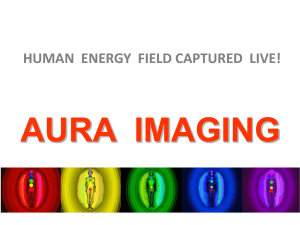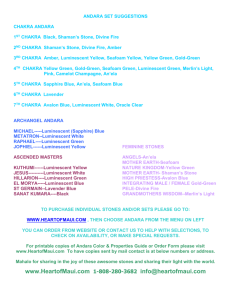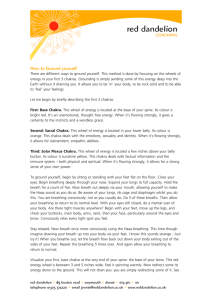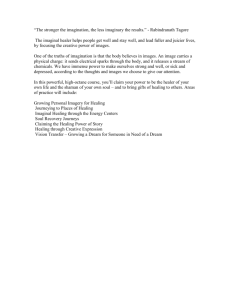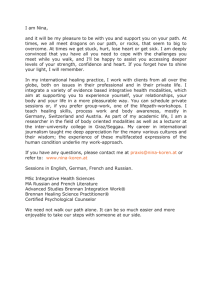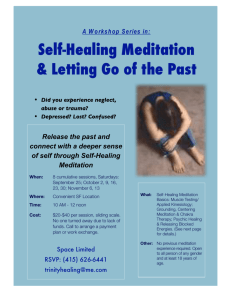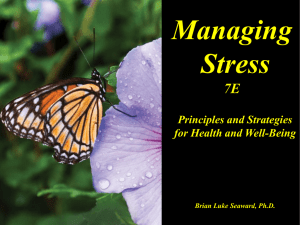A Model for Healing and Recovery
advertisement
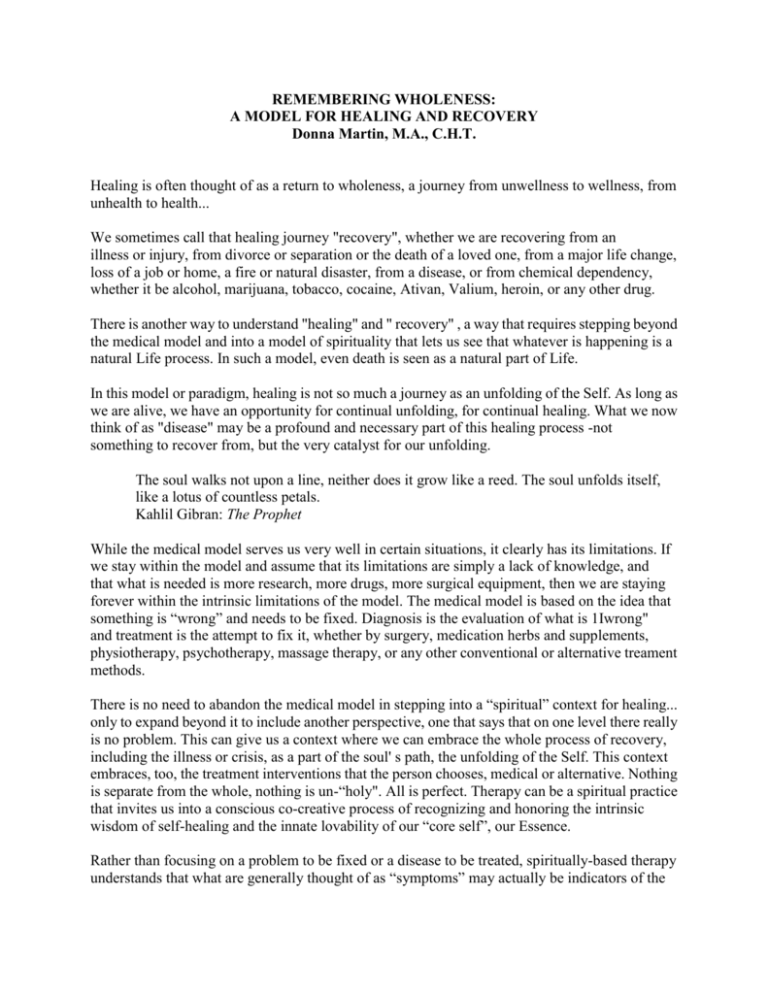
REMEMBERING WHOLENESS: A MODEL FOR HEALING AND RECOVERY Donna Martin, M.A., C.H.T. Healing is often thought of as a return to wholeness, a journey from unwellness to wellness, from unhealth to health... We sometimes call that healing journey "recovery", whether we are recovering from an illness or injury, from divorce or separation or the death of a loved one, from a major life change, loss of a job or home, a fire or natural disaster, from a disease, or from chemical dependency, whether it be alcohol, marijuana, tobacco, cocaine, Ativan, Valium, heroin, or any other drug. There is another way to understand "healing" and " recovery" , a way that requires stepping beyond the medical model and into a model of spirituality that lets us see that whatever is happening is a natural Life process. In such a model, even death is seen as a natural part of Life. In this model or paradigm, healing is not so much a journey as an unfolding of the Self. As long as we are alive, we have an opportunity for continual unfolding, for continual healing. What we now think of as "disease" may be a profound and necessary part of this healing process -not something to recover from, but the very catalyst for our unfolding. The soul walks not upon a line, neither does it grow like a reed. The soul unfolds itself, like a lotus of countless petals. Kahlil Gibran: The Prophet While the medical model serves us very well in certain situations, it clearly has its limitations. If we stay within the model and assume that its limitations are simply a lack of knowledge, and that what is needed is more research, more drugs, more surgical equipment, then we are staying forever within the intrinsic limitations of the model. The medical model is based on the idea that something is “wrong” and needs to be fixed. Diagnosis is the evaluation of what is 1Iwrong" and treatment is the attempt to fix it, whether by surgery, medication herbs and supplements, physiotherapy, psychotherapy, massage therapy, or any other conventional or alternative treament methods. There is no need to abandon the medical model in stepping into a “spiritual” context for healing... only to expand beyond it to include another perspective, one that says that on one level there really is no problem. This can give us a context where we can embrace the whole process of recovery, including the illness or crisis, as a part of the soul' s path, the unfolding of the Self. This context embraces, too, the treatment interventions that the person chooses, medical or alternative. Nothing is separate from the whole, nothing is un-“holy". All is perfect. Therapy can be a spiritual practice that invites us into a conscious co-creative process of recognizing and honoring the intrinsic wisdom of self-healing and the innate lovability of our “core self”, our Essence. Rather than focusing on a problem to be fixed or a disease to be treated, spiritually-based therapy understands that what are generally thought of as “symptoms” may actually be indicators of the healing in process. The role of the therapist is to support our healing process and help us become a more conscious and creative participant in the process of our life. Therapy as a spiritual practice, like other spiritual practices, invites us to move out of ordinary states of consciousness. Some examples of "ordinary" mind states would be thinking, analyzing, remembering, imagining, judging, criticizing, counting, knowing, visualizing, listening, planning, worrying, and so on. A whole other level of mind comes into play with awareness, an aspect of consciousness. One version of this is called mindfulness -just noticing whatever is happening with a quality of non-judgmental awareness and acceptance. The spiritual base reminds us that nothing is insignificant. The journey is one of many small steps, some forward, some back. What changes more than anything else is our level of awareness and self-acceptance, no matter what happens. It is our core self" that can be aware of our various parts, or identities, feelings, and behaviors and trust the inner wisdom of the healing process as it unfolds. In a setting of acceptance and compassion the core self is encouraged more and more to reveal itself separate and distinct from ego and its coping strategies. Therapy may be a powerful opportunity for the healing of past trauma, such as physical, sexual, or emotional abuse. Healing is possible because the "wound" has more to do with what didn't happen that what happened. When a person feels abused, trauma may occur because of an interruption in the natural continuum of response to such an event, or any event that is perceived as threatening. This natural response continuum includes various physiological reactions: the "startle reflex" (flexion, extension), the "scanning reflex" (turning the head and eyes), "fight or flight" movement in the limbs), inhalation, holding the breath, exhalation, voice... Ideally, this response continuum includes being witnessed, accepted, and validated. The feelings need to be experienced without internal or external resistance or judgment. If the internal and/ or external resources are not in place for the person to be able to complete this continuum, a natural protective mechanism is set in motion. This involves a kind of disconnection of consciousness from the mind, the body, and the feelings, as well as a disturbance in the energy body. It is important to understand that any trauma, whether the event was actually life-threatening or not, results in some kind of disconnection and energetic disturbance. All of us have been traumatized to some degree, if only by being born. (The only transition that is as intense, and potentially terrifying, as that from the womb to life, is that from life to "death".) Accidents and operations may actually be as traumatizing for some as abusive experiences such as beatings or sexual assaults. Being left with a strange babysitter, or losing mother in the shopping mall, may be experienced as abandonment. The disconnection occurs because of the experience, not the event. The experience involves the person's perception of what's happening and the feelings of fear, helplessness, and/ or pain. When the fear and/ or pain is intense enough, our natural protective mechanisms involve some kind of disconnection of consciousness from the experience, The mind disconnection usually involves some degree of amnesia, where the person is somewhat mentally unaware of what's happening and later has little or no memory of the event, or even of the time surrounding the event. Some people appear to have effectively forgotten several years of their life, perhaps their entire childhood. The body disconnection (dissociation) may vary from a temporary local numbing to a total out-ofbody experience, where the person actually sees their own body from a vantage point several feet away and usually above the body. This happens frequently in near-death experiences or during surgical operations, for example. The emotional disconnection (shock) involves a shift to a flat or neutral feeling where there is little or no fear, sadness, or emotion generally, a kind of emotional numbness. These disconnected states obviously protect us from experiencing the pain of the event, and stay in place, sometimes for years, until the internal and external resources are available that were absent at the time of the event. The "trauma", then, is stored -suspended or "frozen" in time -in the "unconscious", the nervous system, and the energy body. The energy body stores the trauma in a number of ways: for example, it may be stored as a disturbance (perturbation) in the energy field, or as a block in the flow of energy through the body or as a disruption or constriction in the energy centers (chakras). One way to think of these various disconnections that occur is that an Identity, or subself, is created to hold onto the experience (while another Identity is usually created to respond to the event). These identities are structures created for a purpose, and are not the core self, or essential self. Frequently, the wounded identity and/ or theidentity that was formed to compensate for the experience or keep it from our consciousness becomes confused with our idea about who we are. A readiness for reconnecting with the original experience and for dis-identifying with the coping structure occurs at some point later in our life. Unfortunately, the signals of this readiness are usually misread as symptomatic and treated as a problem. This misunderstanding is not only not supportive of the natural healing process, but it may also generate even more helplessness, shame, and trauma. Frequently, when the coping structure falls apart, what surfaces is the wounded/helpless identity. This may also need to be dismantled for the core self to emerge into consciousness. The signals of trauma healing which are generally misunderstood are the mental, physical, or emotional signs of re-connection. Mentally, these may include gradual or sudden memories, flashbacks, or nightmare images that relate to forgotten (stored) events. Memories may be incomplete and are likely to be quite distorted. Time distortion with memories is very common. The physical reconnecting may include pain, illness, or confusing body sensations -often involving the body parts associated with the trauma. One person I worked with, for example, had been buried alive at age five when she fell in an enormous hole at a construction site. As an adult she suffered from chronic asthma. Another woman, who had been sexually assaulted as a child, suddenly began to experience intense pain during intercourse with her husband. The physical "symptoms" often begin without any particular warning or conscious connection to a past event, and may be diagnosed and treated unsuccessfully for years. Some medical doctors who specialize in chronic pain now routinely ask clients about any history of abuse or other trauma because this link is so common. Emotionally, the reconnection usually manifests as unpredictable feelings of fear, which is the most natural feeling response to a life-threatening experience. Without the presence of a current event or memory stimulus, these sudden feelings of fear are very confusing and may be labelled as anxiety or panic attacks. Instead of being appreciated as indicators of healing, these feelings of anxiety are often treated with medication, as are the physical symptoms. The sudden surges of anxiety that seem to have no apparent connection to one's present life may be the releases of stored energy that has been held in the nervous system, the energy body, and the unconscious for years. There is also a spiritual disconnection that occurs when one's life is traumatically disrupted... as if the rug has been pulled out from under a basic faith in Life... in being supported and protected by a Higher Power... a realization that whatever one- had believed in can no longer be trusted. Just before his death, Einstein identified what he thought was the most important question for man to answer, which was (in his words) "Is the Universe friendly?" Loss of innocence occurs when our previously unquestioned childlike faith in a friendly universe is disrupted. At that time there is a break from Essence to create one or more identity structures designed to keep us "safe" or get our needs met. After that Self- forgetting, we are no longer in Essence (innocence) and the rest of our lives becomes a journey further away from or back towards the true Self. When trauma is frozen in the system, the presence of strong protector parts (internal or external) that suppress the painful feelings can lead to depression. A tremendous amount of energy goes into keeping the disconnection in place. This eventually depletes our natural vitality and life force. Chronic low energy and blocked life force over time generally lead to depression. During a traumatic experience, the energy body is affected in several ways. A distorted pattern in the energy field can become frozen when the natural response continuum is interrupted or Iesisted and the natural release of energy through movement, breath or voice is stopped. This freezing results in the distortion becoming set (frozen) in the energy field. This will generally involve a partial closing of some of the seven major chakras or energy centers, located as follows: 1. root chakra: at the base of the spine...pelvic floor; 2. navel chakra: lower belly /back ...sexual glands; 3. solar plexus: upper abdomen/mid-back... adrenal glands; 4. heart chakra: mid-chest/uppe rback ...thymus ,r: gland; 5. throat chakra: throat/neck... thyroid/ parathyroids; 6. brow chakra: "third eye" /head ...pineal gland; 7. crown chakra: top of the head... pituitary gland. For example, if a child is being molested by a parent or sibling and is threatened to keep quiet, her(his) survival may depend on a closure of the throat center which is the channel for the expression of feelings. This may result in a chronic constriction of the throat chakra, causing throat or voice problems (such as laryngitis). Limiting protective core beliefs may develop to maintain the programming ("it's not safe to say what I feel... it's not okay to ask for what I need"). Any later changes in these core beliefs would involve an opening of the throat chakra and an accompanying release of the blocked energy. If the area of a certain chakra or energy center has closed protectively, there may be later signals of this which indicate a readiness for opening (relaxation) and healing. These might include the following somatic indicators: 1. root; feet and leg problems; bladder, tailbone; 2. pelvis; sexual organs; hips, intestinal (bowel), low back; 3. digestive or breathing difficulties; ulcers; stomach, back; 4. respiratory (asthma, lung ailments, allergies); chest; breast; 5. throat or neck problems; jaw; mouth; laryngitis; 6. eye problems; headaches; dizziness; mental confusion; 7. headaches; scalp problems; cranial (skull) injuries... It is as if the energy in these centers became dense and slow-moving, condensing around a protective belief or an Identity that would keep the person safe (such as "quiet", "intellectual", "confused"...) The so-called "symptom" calls attention to this congested or condensed energy which is wanting to be released and reabsorbed into a more expansive and less solid state. It is not necessary to experience something as serious as incest to produce congestion in the energy centers, however. If an exuberant young child is repeatedly told to be quiet, perhaps because of a tired or ill parent, the throat chakra will also protectively close to help keep the child safe from disapproval. Sometimes people present trauma symptoms but have no memory of an event, either because of amnesia, (one version of the protective disconnection) or perhaps because the " event" may have been an ongoing situation, repeated events that seemed relatively minor -certainly not life-threatening -but which had a cumulative effect. This could contribute to the creation of core beliefs and a particular coping style Identities organized to cope with stressful situations later in life. Usually, the most traumatic experiences involve and affect more than one chakra. Sexual abuse, for example, might affect the root, or base chakra (survival and safety) since the child's survival depends on the parent. Basic security needs are at stake. The second chakra is affected whenever there is a sense of shame about the body and sexuality. The solar plexus (power) would be affected by helplessness and the absence of choice... a sense of victimhood; or when we need to appear helpless to get our needs met. The heart chakra (love and connectedness) is affected whenever we feel unworthy or lonely and isolated (unacceptable). It closes down after loss to protect us from opening up to connection only to experience the pain of separation once again. The throat center closes to help block the expression of feelings when that would lead to disapproval or punishment, or when expressing feelings is totally ineffective in stopping what's happening. The brow center (trust and intuition) may close down when an experience does not honor and validate our inner knowing -when our internal truth is in conflict with our external reality. The crown chakra is affected when our experience seems to cut us off from our connection to the Divine. A parent symbolizes a child's Higher Power. Any misuse of this power may seriously affect the child's spiritual faith, creating doubt in the meaning of Life. Confusion ensues between the idea of a Higher Power (spirituality), the understanding of "love" , and the experience of abuse. There are a number of ways that energy can be unfrozen (or released from its condensed form) -I, and moved, including the use of breath, voice, sound, music; body movement, massage, touch; and by the mind (intention, visualization, mantra, meditation etc). Therapy as a spiritual practice involves the whole person: body, mind, emotions, energy and spirit. Anyone part is a doorway to the whole. The doorway that is opening, whether it be physical, emotional, or whatever, is the gateway to the healing process. In this approach to therapy, all roads lead to Rome and the most appropriate route to follow is generally the one open and inviting you on the healing journey. Usually a traumatic experience results in the formation of limiting beliefs that later become a key part of the therapy process and the personal transformation that is the healing experience. For each chakra affected, a certain kind of limiting belief may be created. This is a protective strategy, designed to keep the wounded part safe from physical threat or emotional disapproval and to prevent further pain from occurring as long as you are vulnerable. A therapist may be able to help you uncover some of the limiting beliefs that determine how you experience life, as well as some of the false Identities that you've confused with your core self. Limiting beliefs are held by these Identities, as are the corresponding perturbations and blocks in the energy body. When you can recognize and observe these coping structures, it is possible to realize that they are not you -you created them in response to what you were experiencing. Here are some examples of such protective beliefs (check out if any of these seem familiar): 1) Root chakra (survival/support): "I'm not safe." "It's not a safe world." "It's not safe to... (see, speak, know... etc.)". 2) Navel chakra (sexuality /physicality): "I'm ugly." "I should have been a boy (girl)." "My body is too (thin... fat... awkward... small... big…etc.” “Sex is shameful.” “Love = sex.” 3) Solar plexus (power): "I can't..." "I have no choice." "It's not okay to be powerful." "I'm weak." "I'm a victim." "It's all my fault." "It's all their fault." 4. Heart chakra (love/ connectedness): "I'm alone." "I'm unworthy." "I'm unlovable." "I don't belong." "I don't fit in." 5. Throat chakra (expression/ creativity): "It’s not okay to express (anger...hurt...needs... wishes...feelings...etc.)" "I'm not... ( artistic.. .m usical.. .creative...etc) ." 6. Brow chakra (intuition/trust in self): "I'm wrong." "I can't understand." "I can't trust myself." "It's not okay to see...to know..." "It’s not okay to make a mistake." 7. Crown chakra (spirituality): "My life has no meaning." "There is no God." "What's the point?" "I don't believe in anything." "My life (...things...) should be different." You could ask yourself "who thinks (such-and- such belief)... ?" Ask yourself what came first, you or the belief... Have you created a self-image (Identity) that holds that belief in order to cope with certain situations in life? ...in order to avoid anything? ...in order to get certain needs met? It is possible to identify a life-expanding statement for each chakra -statements that could be used, not as alternative beliefs but rather to bring to awareness the constraints that operate: mentally as internal voices, physically as tension, emotionally as fears, and energetically as constrictions -blocked energy flow. Here are some examples: 1. "I'm perfectly safe here." "It's safe to..." 2. "My body is beautiful." "It's wonderful that I am a woman...(man)." 3. "My life is in my hands." "I can do what I choose." "I always have a choice." 4. "I'm lovable just as I am." "I belong here." "I am loved." 5. "It’s okay to say what I feel (...want...need...)" 6. "I have a wise part that knows." "I can trust my intuition." "The answer is within me." "It's okay to make a mistake." 7. "My life has meaning." "I am on my path." One way to use such statements is to think or say them and notice any internal reaction, any thoughts, feelings, or body sensations that seem to disagree or resist these possibilities. As these pop up, just let yourself notice and study them, how they present, where they are, what they remind you of... Don't try to change them or get rid of them. Simply pay attention. Be aware of them as thoughts or voices, as feelings or body sensations... then simply notice them as frozen or slow-moving energy. Therapy as a spiritual practice operates in supreme faith that: a) your essential core self is intact, undamaged; and b) what appears to be a problem or symptom may be in reality an indication of selfhealing. When you go for therapy because of past trauma resulting in some ongoing "problem" , such as anxiety or chronic pain (reconnection signals) or in some crisis caused by addictive behavior (extreme coping strategy), a spiritually-based therapist begins by establishing a sense of safety and trust with an attitude of acceptance and appreciation. In this kind of therapy, there is a quality of total presence without force, of willingness without effort, of caring without urgency or attachment. Sometimes Life provides a nudge to bring something to awareness that is ready for change. This may take the form of an accident" that re- injures the original site of the trauma or draws attention to the constricted chakra (ie. whiplash). Sometimes the presence of a child mirrors the part that was traumatized. Frequently a current event or situation, such as losing a job or a relationship, or even watching a powerful movie, is exactly what is needed to set the healing process in motion. The least important part of the reconnection for trauma healing is memory. It is important not to worry about retrieving forgotten memories of the event. What is important is the completion of the physical and energy body response, which will be signaling what needs to happen. Perhaps the most powerful single tool for healing past trauma is non-judgmental mindfulness, particularly body mindfulness. What the mind "remembers” or imagines about the event may be tremendously distorted. Frequently our perception of an event, perhaps through the eyes of a child, was a limited or inaccurate reading of the situation. It is what is perceived that leaves an impression, whether or not it is accurate, and so becomes the story that holds onto the emotional wound. Embracing therapy as a spiritual practice allows us, again and again, to witness and trust the wisdom of Life, to appreciate the beauty of the spirit, to let go of unnecessary suffering and false identities that keep us stuck. Each step of our healing journey then becomes both a sacred experience and a cause for celebration. When you see yourself and someone else as one being, When you know the most joyful day and the most terrible night as one moment, then Awareness is alone with its Lord. With repeated meditation practice the expanse of the visible universe with all its qualities dissolves to nothing, to where there is only health and a great joy. All teaching comes to this. Lalla (Poems by Lalla translated by Coleman Barks in Naked Song.) Donna Martin, M.A. is a Certified Hakomi Therapist who is part of Ron Kurtz's teaching team for Loving Presence Workshops and Psychotherapy as a Spiritual Practice Trainings. She is a charter member of the International Association of Yoga Therapists, and an editor of IAYT's Journal. In addition to her private practice as a bodymind therapist, Donna works part-time as an alcohol and drug addiction counselor. She regularly teaches yoga, relaxation, and body-mind therapy for Post-Traumatic Stress, as well as offering retreats and workshops for therapists throughout North America. She can be reached at (604) 374-2514.
